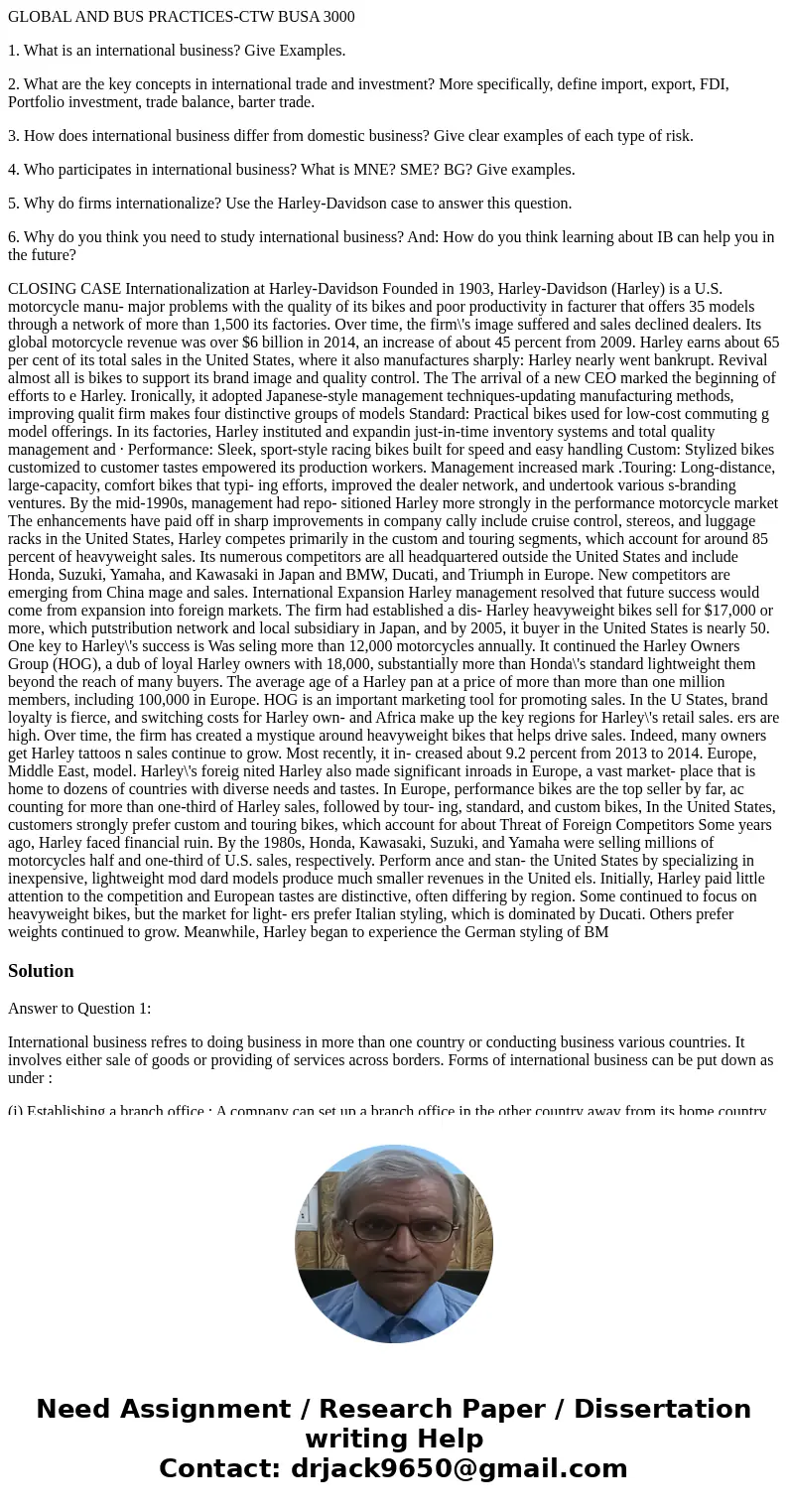GLOBAL AND BUS PRACTICESCTW BUSA 3000 1 What is an internati
GLOBAL AND BUS PRACTICES-CTW BUSA 3000
1. What is an international business? Give Examples.
2. What are the key concepts in international trade and investment? More specifically, define import, export, FDI, Portfolio investment, trade balance, barter trade.
3. How does international business differ from domestic business? Give clear examples of each type of risk.
4. Who participates in international business? What is MNE? SME? BG? Give examples.
5. Why do firms internationalize? Use the Harley-Davidson case to answer this question.
6. Why do you think you need to study international business? And: How do you think learning about IB can help you in the future?
CLOSING CASE Internationalization at Harley-Davidson Founded in 1903, Harley-Davidson (Harley) is a U.S. motorcycle manu- major problems with the quality of its bikes and poor productivity in facturer that offers 35 models through a network of more than 1,500 its factories. Over time, the firm\'s image suffered and sales declined dealers. Its global motorcycle revenue was over $6 billion in 2014, an increase of about 45 percent from 2009. Harley earns about 65 per cent of its total sales in the United States, where it also manufactures sharply: Harley nearly went bankrupt. Revival almost all is bikes to support its brand image and quality control. The The arrival of a new CEO marked the beginning of efforts to e Harley. Ironically, it adopted Japanese-style management techniques-updating manufacturing methods, improving qualit firm makes four distinctive groups of models Standard: Practical bikes used for low-cost commuting g model offerings. In its factories, Harley instituted and expandin just-in-time inventory systems and total quality management and · Performance: Sleek, sport-style racing bikes built for speed and easy handling Custom: Stylized bikes customized to customer tastes empowered its production workers. Management increased mark .Touring: Long-distance, large-capacity, comfort bikes that typi- ing efforts, improved the dealer network, and undertook various s-branding ventures. By the mid-1990s, management had repo- sitioned Harley more strongly in the performance motorcycle market The enhancements have paid off in sharp improvements in company cally include cruise control, stereos, and luggage racks in the United States, Harley competes primarily in the custom and touring segments, which account for around 85 percent of heavyweight sales. Its numerous competitors are all headquartered outside the United States and include Honda, Suzuki, Yamaha, and Kawasaki in Japan and BMW, Ducati, and Triumph in Europe. New competitors are emerging from China mage and sales. International Expansion Harley management resolved that future success would come from expansion into foreign markets. The firm had established a dis- Harley heavyweight bikes sell for $17,000 or more, which putstribution network and local subsidiary in Japan, and by 2005, it buyer in the United States is nearly 50. One key to Harley\'s success is Was seling more than 12,000 motorcycles annually. It continued the Harley Owners Group (HOG), a dub of loyal Harley owners with 18,000, substantially more than Honda\'s standard lightweight them beyond the reach of many buyers. The average age of a Harley pan at a price of more than more than one million members, including 100,000 in Europe. HOG is an important marketing tool for promoting sales. In the U States, brand loyalty is fierce, and switching costs for Harley own- and Africa make up the key regions for Harley\'s retail sales. ers are high. Over time, the firm has created a mystique around heavyweight bikes that helps drive sales. Indeed, many owners get Harley tattoos n sales continue to grow. Most recently, it in- creased about 9.2 percent from 2013 to 2014. Europe, Middle East, model. Harley\'s foreig nited Harley also made significant inroads in Europe, a vast market- place that is home to dozens of countries with diverse needs and tastes. In Europe, performance bikes are the top seller by far, ac counting for more than one-third of Harley sales, followed by tour- ing, standard, and custom bikes, In the United States, customers strongly prefer custom and touring bikes, which account for about Threat of Foreign Competitors Some years ago, Harley faced financial ruin. By the 1980s, Honda, Kawasaki, Suzuki, and Yamaha were selling millions of motorcycles half and one-third of U.S. sales, respectively. Perform ance and stan- the United States by specializing in inexpensive, lightweight mod dard models produce much smaller revenues in the United els. Initially, Harley paid little attention to the competition and European tastes are distinctive, often differing by region. Some continued to focus on heavyweight bikes, but the market for light- ers prefer Italian styling, which is dominated by Ducati. Others prefer weights continued to grow. Meanwhile, Harley began to experience the German styling of BMSolution
Answer to Question 1:
International business refres to doing business in more than one country or conducting business various countries. It involves either sale of goods or providing of services across borders. Forms of international business can be put down as under :
(i) Establishing a branch office : A company can set up a branch office in the other country away from its home country and run business in the international country through that office.
(ii) Exports and Imports : A company from its home country can either import or export i.e. buy or sell goods or services with another country.
(iii) Agency : International business can also be carried out through an agent located in a international country on acts on behalf of the company/ person for sale of goods or providing services.


 Homework Sourse
Homework Sourse